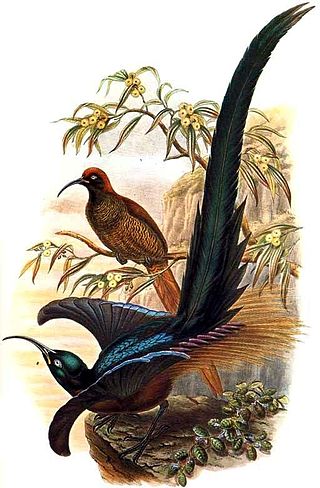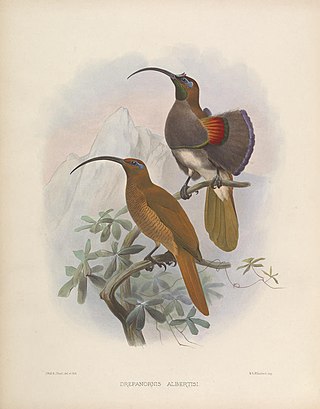
The birds-of-paradise are members of the family Paradisaeidae of the order Passeriformes. The majority of species are found in eastern Indonesia, Papua New Guinea, and eastern Australia. The family has 45 species in 17 genera. The members of this family are perhaps best known for the plumage of the males of the species, the majority of which are sexually dimorphic. The males of these species tend to have very long, elaborate feathers extending from the beak, wings, tail, or head. For the most part, they are confined to dense rainforest habitats. The diet of all species is dominated by fruit and to a lesser extent arthropods. The birds-of-paradise have a variety of breeding systems, ranging from monogamy to lek-type polygamy.

The genus Sayornis is a small group of medium-sized insect-eating birds, known as phoebes, in the tyrant flycatcher family Tyrannidae.

Wilson's bird-of-paradise is a species of passerine bird of the family Paradisaeidae.

The standardwing bird-of-paradise, also known as Wallace's standardwing or as the standardwing, is a species of bird-of-paradise. It is the only member in monotypic genus Semioptera.

The mountain robin, also known as subalpine robin, alpine robin or cloud-forest robin, is a species of bird in the family Petroicidae. It is found sparsely throughout the New Guinea Highlands.

The black sicklebill is a large member of the birds of paradise family, Paradisaeidae. This species is found throughout most of central New Guinea and the Vogelkop region to the northwest in montane forests at altitudes from 1,800 to 2,150 m.

Epimachus is a genus of birds-of-paradise (Paradisaeidae) that includes two species, found in the highland forests of New Guinea. They are the largest members of the family. The common name "sicklebill" refers to their long, decurved, sickle-shaped bill.

The brown sicklebill is a species of bird-of-paradise that is found in the mountain forests of New Guinea.

The Huon astrapia, also known as Rothschild's astrapia, Huon bird-of-paradise, or Lord Rothschild's bird-of-paradise, is a species of bird-of-paradise belonging to the genus Astrapia. Like most of its congeners, A. rothschildi is a rather elusive member of its genus and family.

The Splendid astrapia is a species of Astrapia of the birds-of-paradise family, Paradisaeidae, and one of the least known and most elusive of its family and genus.

The pale-billed sicklebill is a species of sicklebill that belongs to the family Paradisaeidae, which contains the birds-of-paradise.

The black-billed sicklebill, also known as the buff-tailed sicklebill, is a species of bird-of-paradise. It, along with its congener, are the only members of the genus Drepanornis.

The buff-tailed sicklebill is a species of hermit hummingbird from the lower Andes and adjacent west Amazonian lowlands from southern Colombia and northern Ecuador to Peru and Bolivia.

The astrapian sicklebill, also known as the green-breasted riflebird, is a bird in the Paradisaeidae family that was proposed by Erwin Stresemann to be an intergeneric hybrid between an Arfak astrapia and black sicklebill, an identity since confirmed by DNA analysis.

Elliot's bird of paradise is a bird in the family Paradisaeidae, first described by Edward Ward in 1873, but which was later proposed to be a hybrid rather than a “real” species, an identity since confirmed by DNA analysis.
The false-lobed astrapia, also known as the false-lobed long-tail, is a bird in the family Paradisaeidae that was proposed by Erwin Stresemann to be an intergeneric hybrid between a long-tailed paradigalla and black sicklebill. Another interpretation that has been put forward is that the only known specimen is an immature Elliot's bird-of-paradise. However, a 2024 DNA study found that it is an F1 hybrid between a long-tailed paradigalla and an Arfak astrapia.
The mysterious bird of Bobairo, named as such by Errol Fuller, is a bird in the family Paradisaeidae that is presumed to be an intergeneric hybrid between a black sicklebill and greater lophorina. Only one adult male specimen is known of this bird, and is held in the Netherlands National Museum of Natural History in Leiden. It derives from Bobairo, near Enarotali on Lake Paniai in the Weyland Mountains of Western New Guinea.
xeno-canto is a citizen science project and repository in which volunteers record, upload and annotate recordings of bird calls and sounds of orthoptera and bats. Since it began in 2005, it has collected over 575,000 sound recordings from more than 10,000 species worldwide, and has become one of the biggest collections of bird sounds in the world. All the recordings are published under one of the Creative Commons licenses, including some with open licences. Each recording on the website is accompanied by a spectrogram and location data on a map displaying geographical variation.

The black-capped paradise kingfisher or black-headed paradise kingfisher, is a bird in the tree kingfisher subfamily, Halcyoninae. It is native to several islands in the Bismarck Archipelago to the east of New Guinea. Like all paradise kingfishers, this bird has colourful plumage with a red bill and long distinctive tail streamers.
























